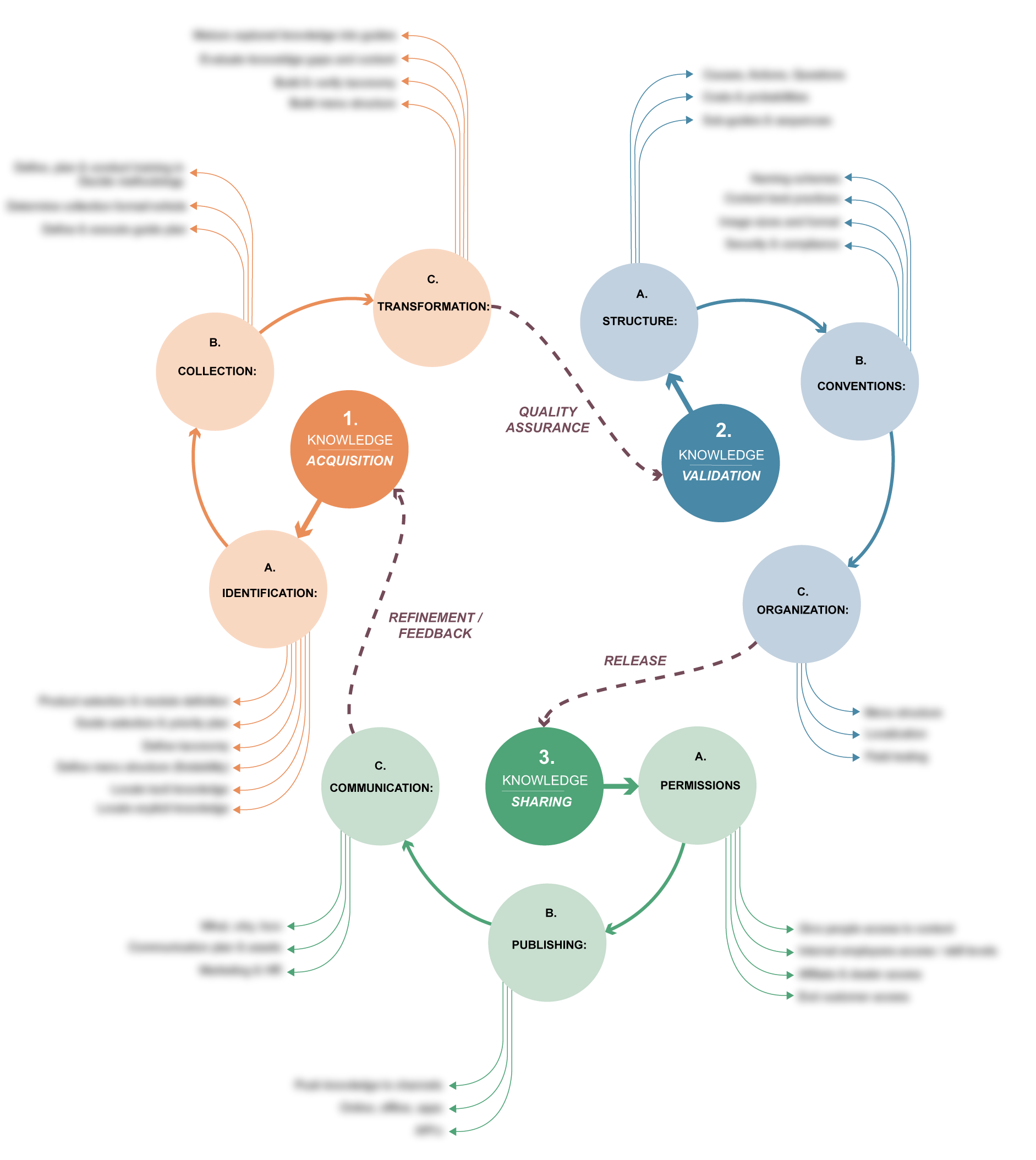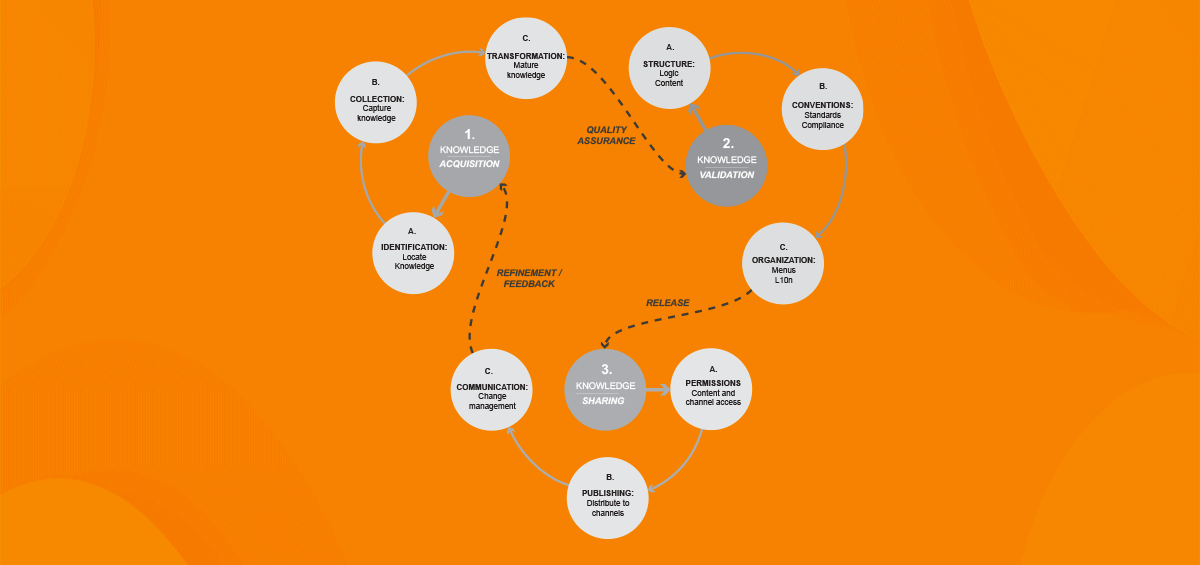In a previous blog post, we delved into the intriguing question of “How much time should you invest in an expert troubleshooting knowledge base?” It provided valuable insights into the time-consuming nature of building and maintaining a knowledge base and pinpointed where the hours and effort are invested. This understanding underscores the importance of the Dezide Knowledge Value Chain (KVC), a powerful framework that promises to streamline and supercharge the knowledge-building process.
A journey through the KVC and the impacts of LLMs
Today, we embark on a journey through the Dezide Knowledge Value Chain (KVC), dissecting its core components one by one. Each phase – acquisition, validation, and sharing – plays a pivotal role in transforming raw data and information into actionable insights and knowledge, and we’ll leave no stone unturned in exploring their nuances. As we progress through the KVC, we’ll also introduce a game-changer – Large Language Models (LLMs). These cutting-edge AI systems are poised to change how organizations manage and leverage knowledge in certain areas of the Knowledge Value Chain. So, let’s get started with the heart of the Knowledge Value Chain, where we’ll uncover the secrets of knowledge management related to technical troubleshooting and explore how LLMs are reshaping the landscape.
This article introduces the concept and provides an overview of the Dezide KVC, and the subsequent articles will dive deeper into each major phase and analyze the impact of LLMs in each.
Intro
In the ever-evolving world of field service, knowledge is becoming increasingly important. It’s no wonder that service organizations are emphasizing the value of knowledge and its management. Knowledge value chains effectively ensure that the knowledge needed to support an organization’s goals is captured, shared, and utilized. By understanding the components of a knowledge value chain, organizations can better ensure that the knowledge they need to succeed is available and used to its full potential. I will explore Dezide’s recommended Knowledge Value Chain (KVC) for efficient guided troubleshooting in this article. As such, The KVC is Dezide’s process for building the best possible knowledge base for efficient technical troubleshooting using a set of practices that, when combined, results in a knowledge base that supports your field service engineers on-site to solve problems in advanced products as quickly as possible and using as few spare parts as possible too. All while coming across as top professionals ensuring high customer satisfaction and long-lasting relationships.
Through more than 20 years of experience, we have collected and described what we believe is the best approach to acquire, validate, and share the technical troubleshooting knowledge in your organization and distribute it in the best possible format to the end-users.
As such, these articles contain diagrams, text, and reference material explaining our knowledge transformation process into enterprise troubleshooting value. It’s ideal for anyone looking to learn more about the knowledge value chain process, and for training knowledge producers in Dezide, and we have deliberately kept the tone informal. It’s ideal for anyone whose time, attention, and tolerance for opaque “consult-speak” are stretched thin. We have taken an advanced topic, such as organizational learning and information system activities, and distilled it into a set of very tangible actions using our 20 years of experience working with field service in complex organizations.
In short, the Dezide KVC is:
-
A user manual/handbook for producers of knowledge in Dezide.
-
A troubleshooting tool for quickly identifying and fixing knowledge-value gaps.
-
An ideation engine that helps you use data, information, and knowledge more effectively
This article series contains most of the secret sauce that makes this framework successful for our customers.
But why do we need such an elaborate process for building a troubleshooting knowledge base for our service teams?
Let’s look at that next ->
Why do we need the Knowledge Value Chain?
The KVC is needed to capture and add all relevant and essential information to the knowledge base. In a step-by-step approach, the KVC helps Dezide and our clients ensure that everyone knows what knowledge is needed, who is responsible for adding it to the knowledge base, and where it can be found.
The Knowledge Value Chain model is an invaluable framework for service organizations that want to maximize the potential of their troubleshooting knowledge resources through using Dezide. The model outlines a comprehensive continuous process for organizations to identify, capture, store, validate, and effectively share knowledge. By following the model, organizations can develop an understanding of their knowledge gaps and take the necessary steps to acquire the missing knowledge. Once the knowledge has been acquired, it is transformed into Dezide’s model for troubleshooting knowledge in the dynamic guides in a secure and organized manner to ensure that it is easily accessible whenever needed.
Finally, organizations must create a collaborative learning and innovation culture to ensure that knowledge is continuously being improved upon and refined. Following the Knowledge Value Chain ensures that those procedures are established and maintained so valuable user feedback is captured, processed, and updated in the knowledge base accordingly. We use the KVC to ensure service organizations effectively manage their troubleshooting knowledge resources and gain a competitive advantage.
And, even though the process is comprehensive and involves many daily operational tasks that need to be carried out by the back-office team supporting Dezide, the framework is flexible enough that it can be handled by as little as a one-man army or an entire department if your organization dictates it. The framework supports your organization and grows with you as required.
Dezide is always there through your service transformation journey to ensure you get a good start and that all action items in the KVC get the attention required and are executed properly. Each of the three major clusters in the KVC (Acquisition, Validation, Sharing) contains a catch-all roadmap that will help you set up the necessary procedures and help you navigate your organization to secure the right resources. The roadmaps are supplemented with assets to help you get started, and our implementation specialists will help you every step of the way to success.
Overview of the Dezide KVC
The knowledge value chain is a framework that helps organizations identify the key elements necessary to maximize the value of their knowledge assets. It consists of three main stages: acquisition, validation, and sharing. At the acquisition stage, knowledge is acquired from internal and external sources. At the validation stage, knowledge is verified, cleaned, translated, and tested. At the sharing stage, knowledge is shared with end-users to create value. By understanding the knowledge value chain, organizations can ensure that their knowledge assets are utilized to improve field service efficiency, thereby driving value creation.
The diagram below presents the circular flow called the Knowledge Value Chain, which is composed of three main stages, each with three components in a systematic process for managing knowledge:

Acquisition: Unlocking Knowledge's Source
In the world of knowledge management, the Acquisition phase is where it all begins. It’s the process of uncovering the treasures of information, both within and beyond an organization’s walls. From tapping into internal expertise to harnessing external sources, both explicit and tacit, this phase is about identifying what knowledge is needed to tackle challenges and drive progress. This first phase is about identifying, collecting, and refining the knowledge to make it usable.
Validation: Ensuring Knowledge's Precision
Once knowledge is acquired, it’s time for the Validation phase – the critical step of refining and verifying the information. This phase ensures that the acquired knowledge is not only accurate but also actionable. It’s where we separate the signal from the noise, confirming that the troubleshooting guides and insights are on-point and effective. In this phase, the knowledge that has been acquired is structured and organized according to certain standards and conventions, ensuring that it is logical, coherent, and compliant with relevant norms.
Sharing: Empowering with Knowledge Access
With knowledge in hand and precision guaranteed, the next phase is Sharing – where the acquired and validated knowledge is put to work. This is the stage where field service staff and other end-users gain access to the knowledge they need to excel in their roles. Permissions are set to control access, then the knowledge is published through various channels, and finally, it is communicated, often involving change management to ensure the new knowledge is adopted and utilized effectively. From setting permissions and distribution channels to effective communication strategies, Sharing is all about making sure that knowledge is not just available but also accessible and understood by those who need it most.
Continuous improvement
As you can see, the entire chain is a closed loop, as knowledge is dynamic and needs to be updated continuously to ensure that the field service teams always have the latest and greatest reference troubleshooting information when fixing complex issues.
Quality Assurance and Refinement/Feedback loop: The diagram includes a feedback loop between Knowledge Acquisition and Knowledge Sharing, indicating that there should be continual quality assurance and refinement based on feedback, highlighting the iterative improvement process.
Release loop: An arrow from Knowledge Validation to Knowledge Sharing labeled “Release” indicates the point at which knowledge is officially distributed. Continuous delivery of new and updated important knowledge ensures that the entire workforce always works according to the latest standards.
Overall, the Knowledge Value Chain is a conceptual framework that outlines the steps from identifying knowledge to sharing it in a structured and controlled manner, emphasizing continual improvement and quality assurance.
Conclusion
In conclusion, the Knowledge Value Chain (KVC) is not just a theoretical framework; it’s a practical roadmap for service organizations looking to harness the power of knowledge to improve their field service efficiency and drive value creation. The core components of the KVC – acquisition, validation, and sharing – is essential for building and maintaining a technical troubleshooting knowledge base effectively.
In the end, the Knowledge Value Chain isn’t just about managing knowledge; it’s about creating a culture of learning, innovation, and collaboration within your organization. It’s a roadmap to gaining a competitive advantage by making sure that your troubleshooting knowledge resources are continuously improved and refined. The KVC can guide you toward building a knowledge base that empowers your field service engineers, satisfies your customers, and strengthens long-lasting relationships, ensuring that knowledge remains a cornerstone of your organization’s success.
Moreover, the KVC is a flexible framework that can be tailored to the specific needs and resources of any organization, whether it’s a one-person operation or a large department.
In the next post, I will dig deeper into Acquisition to explore its operational activities.
Dezide’s commitment to supporting organizations in their service transformation journey ensures that every step of the KVC process receives the attention and execution required for success.



